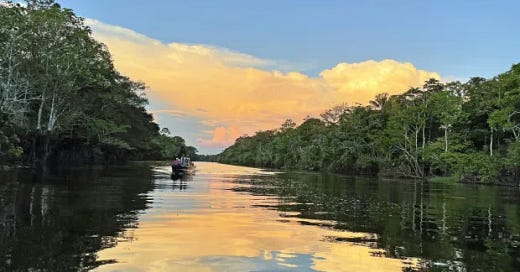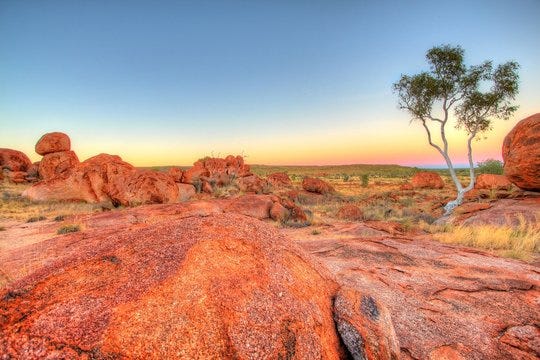People vs the Biosphere:
Three examples: How to protect the natural environment in Brazil. Madagascar, and Australia
For those of us in Europe and North America, it is easy to make the trade-offs between urbanization and protecting the environment. Brazil must protect the rainforests to fight climate change. Madagascar and Australia must protect wild spaces because of the rich and unique diversity of animals found nowhere else. But we often think that the ignorant inhabitants of these areas don’t see the value in that.
It isn’t quite that simple. The people of these countries have a different and more immediate set of requirements. Usually, these requirements center around economic pressures. The need to feed their citizens, generate value (money), and the need to improve their lives.
Biodiversity in Brazil
Brazil’s Amazon Rainforest has been called “the lungs of the world” for its ability to take carbon dioxide out of the atmosphere and release oxygen in its place. The world's largest tropical rainforest hosts many unique and endemic species. It houses at least 10% of the world’s known biodiversity. It is home to about 2 ½ million indigenous people from 350 ethnic groups. Approximately 60 of these groups are still largely isolated.
The Amazon rainforest is massive, about twice the size of India, but is coming under more pressure as the need for farmland grows and the minerals found here are mined. The rainforest has large quantities of copper, tin, nickel, bauxite, manganese, and gold. Pressures on the rainforest mean that the Amazon has lost approximately 17% of its rainforest since 2000.
The rest of the world has begged Brazil to save the rainforest without providing much support. They have been promised support, but it usually is not forthcoming.
The Convention on Biological Diversity (cbd.int) does a excellnt job of pulling out the importance of the island nation.
Brazil is the most biologically diverse country in the world. It is classified at the top among the world’s 17 megadiverse countries, and second only to Indonesia in terms of species endemism. It contains two biodiversity hotspots (the Atlantic Forest and the Cerrado), six terrestrial biomes and three large marine ecosystems. At least 103,870 animal species and 43,020 plant species are currently known, comprising 70% of the world’s catalogued animal and plant species. It is estimated that Brazil hosts between 15-20% of the world’s biological diversity, with the greatest number of endemic species on a global scale. Brazil’s biodiversity is ever-expanding, with an average of 700 new animal species discovered each year.
The United States has promised billions to Brazil if they save the rainforest. Brazil has demanded to see some money upfront, but that hasn’t happened. And so, Brazil views the promise skeptically.
Why does the destruction continue? This area is rich in resources and potential, and Brazilian politicians want to improve their citizen’s lives. Whether for charitable reasons or simply to get reelected, the desire for living standards improvement is an admirable goal. And so, we have two very admirable goals here conflicting. Since Brazil controls the rainforest, the population’s goals are the driving force.
Brazil does acknowledge and attempt to save parts of the rainforest. Other countries in this position, like Indonesia, are even less moved to save the rainforest at the expense of the population’s standard of living.
GDP per capita: $7,510
Economy “middle income developing mixed economy.”
Biodiversity in Madagascar – a Poorer Country
Brazil's GDP per capita and economy are noted above because the rate of habitat loss is directly related to the wealth of a nation. We can see that with Madagascar.
GDP per capita: $501
Economy “one of the poorest in the world.”
The trade-off between biodiversity needs vs. economic needs is even harder to justify in one of the world’s poorest countries. Where the Brazilian rainforest has shrunk by about 17%, the forests in Madagascar have fallen by 80%. And the biodiversity there is striking. The Convention on Biological Diversity describes Madagascar here.
Madagascar is a megadiverse country with a high concentration of endemic species. Its ecosystems include many types of forests, savannah, steppes, rivers, lakes, wetlands, mangroves, drylands and reefs. Currently, these unique ecosystems are home to approximately 12,000 species of vascular plants (96% endemic), 586 species of ferns (45% endemic), 194 species of palms (97% endemic), 1000 species of orchids (85% endemic), 389 species of reptiles (90% endemic), 278 species of amphibians (100% endemic), 282 species of birds (37% endemic), 159 species of fish (66% endemic), 104 species and subspecies of lemurs (100% endemic), 60 species of non-flying small mammals (92% endemic), 43 species of bats (73% endemic) and 13 species of carnivore (77% endemic). With 5,600 km of coastline, coastal areas are composed of natural environments that are among the richest and most diversified in the Indian Ocean region, including coral reefs, mangroves, phanerogam seagrass beds, estuaries and coastal marshes. Studies and literature reviewed indicate the presence of 752 coral fish species in Madagascar. The diversity of Malagasy marine mammals is represented by 28 species, including 27 cetacean species, and only one species of the order Sirenia (Dugong dugon).
The people of Madagascar have cleared much of the land for agriculture and urban use. With a GDP of $500 a year, one cannot blame the people for trying to better their lives, even at the cost of species loss. The UN and France have worked to provide more jobs and diversify the economy, but it has not appreciably changed the underlying issues. And the Madagascar population is growing quickly, putting more pressure on resources. At the nation's founding in 1960, the population was 5.2 million. Today, the population is 30 million.
Climate change is also affecting Madagascar’s flora and fauna. To date this has primarily been in the coastal areas and coral reefs, but future weather patterns may bring unexpected pressure.
Australia – a rich country
GDP per capita: $60,450
Economy “rich”
Australia’s biodiversity is also unique. From the Convention on Biological Diversity:
Australia’s biodiversity is both rich and unique; between 7 and 10 per cent of all species on Earth occur in Australia. A report prepared for the Australian Biological Resources Study in 2009 estimated that 566,398 species exist in the country. Australia’s biodiversity has developed largely in isolation over many millions of years, making it one of the world’s megadiverse countries with a high level of endemism across a broad range of taxa. Australian biodiversity has been influenced by the range and diversity of environmental conditions in Australia, which are different from most other countries due to characteristics such as nutrient-poor soils, natural climatic variability, high fire frequencies and a generally flat topography. Australia’s terrestrial and marine biodiversity is important both nationally and globally, establishing an obligation for its conservation and sustainable use.
Australia is a rich country, and the main threats to biodiversity here are the demands of the population on a large country with little farmland and scarce natural fresh water. There are also many rich mining sites, but extraction practices are destructive.
Australia’s vast outback lends itself to a false sense of unlimited potential. It is so large that it seems able to absorb a lot of growth. But that is not always correct. Much of the arable outback has already been developed for farms or urban development, threatening many of the endemic species of both animals and plants. Much of the desert that is unsuitable for humans is also unsuitable for many animals. This means that the wealthiest biodiverse areas are the most impacted by people.
The Australian government and people are keenly aware of the need to protect endemic species and land, but that is a recent development. In particular, the islands around the nation are being cleared of introduced species that threaten local animals and plants. In Australia, as in the United States, climate change denial is widespread among politicians. Their corporate donors find that action on climate change will negatively affect their bottom lines, and so they campaign to stop action.
Conclusion
Protecting rich biodiversity is a critical goal in the world. Unfortunately, it comes at a cost many countries cannot pay. For the United States and Europe to complain about habitat and species loss now rings hollow in much of the world. Europe and the United States wiped out thousands of species in their economic development, contributing the most to greenhouse gas emissions.
Even for those countries that share our concerns, the demands of their citizens outweigh the tradeoffs that would have to occur. Even when the world comes together to save a species, it usually is a “photogenic” one, like Amazon dolphins, Madagascar Lemurs, and Australian Quokkas. Even well-intentioned people often ignore the ecosystems around these animals.
Money might help save some areas. Economic development might save some biodiversity. And some areas, like South Africa and Tanzania, have found more money in tourism than in economic extraction. But this doesn’t help more obscure, but equally important, biodiversity loss.
The future will see more species loss. I don’t know how to fix it.





